I. Introduction to AI-DAPT
AI-DAPT (AI for Data-centric AI Pipelines Transformation) represents a groundbreaking EU-funded project designed to leverage advanced AI technologies across various industries. By integrating data-centric methodologies with AI pipelines, AI-DAPT aims to address complex challenges in domains such as Health, Robotics, Energy, and Manufacturing. This initiative not only enhances operational efficiencies but also fosters innovation and competitiveness in industrial sectors through intelligent data-driven solutions.
II. AI-DAPT Concept and Technical Architecture
Concept Overview
AI-DAPT adopts a structured approach that spans the entire lifecycle of AI solutions, emphasizing robust data management and sophisticated AI model deployment. The project begins with meticulous data design and preparation, progresses through model development and optimization, and culminates in real-time monitoring and adaptive learning. This phased methodology ensures that AI solutions are not only accurate and reliable but also adaptable to evolving operational needs.

Technical Architecture
The technical architecture of AI-DAPT comprises several interconnected layers that collectively manage the complexities of AI-driven processes:
- Data Lifecycle Management: Encompasses strategies for data collection, integration, and governance, ensuring that data used in AI models are comprehensive, reliable, and compliant with regulatory standards.
- AI Lifecycle Management: Facilitates the development, training, and deployment of AI models. This layer incorporates methodologies for model selection, hyperparameter tuning, and performance evaluation to achieve optimal predictive accuracy.
- Data/AI Execution Services: Orchestrates the execution of data and AI pipelines, ensuring seamless integration between data sources, processing engines, and AI algorithms. This layer supports real-time data processing and decision-making capabilities.
- Data-AI Insights Services: Provides interfaces for data scientists and domain experts to collaborate on data-driven insights. This includes visualization tools, analytical dashboards, and interactive reports that facilitate informed decision-making based on AI-generated insights.
- Data-AI Pipeline Monitoring Services: Monitors the health and performance of deployed AI models and data pipelines. This includes detecting model drift, assessing data quality, and triggering alerts for intervention when anomalies occur.
- Platform Management Services: Delivers foundational services that support the entire AI-DAPT ecosystem. This includes security management, scalability enhancements, and infrastructure optimization to ensure the reliability and efficiency of AI deployments.
- Security and Privacy Services: Implements robust security protocols and privacy measures throughout the AI-DAPT framework. This ensures compliance with data protection regulations and safeguards sensitive information from unauthorized access or misuse.
III. Key Components and Methodologies
Data-Centric AI Pipelines
AI-DAPT emphasizes the critical role of data in developing AI solutions that are accurate, scalable, and ethically sound. Key components of data-centric AI pipelines include:
- Data Design: Identification and selection of appropriate data sources based on domain expertise and specific AI solution requirements.
- Exploratory Data Analysis: Comprehensive analysis of data characteristics using statistical methods, data visualization techniques, and domain knowledge to uncover patterns and insights.
- Data Documentation: Cataloging metadata and data provenance to ensure transparency, reproducibility, and accountability in AI model development.
- Data Valuation: Evaluation of data quality, bias detection, and spurious correlation analysis to mitigate risks associated with misleading data inputs.
Hybrid Science-Guided ML
AI-DAPT integrates hybrid science-guided ML models that combine domain knowledge with data-driven approaches to enhance predictive accuracy and reliability. This approach includes:
- First-Principles Models: Incorporating physics-based or mechanistic models that capture underlying principles and relationships within the data, ensuring scientifically consistent predictions.
- Machine Learning Models: Leveraging data-driven algorithms such as neural networks, decision trees, and ensemble methods to learn from large datasets and adapt to complex patterns.
- Hybrid Model Integration: Implementing strategies for combining first-principles models with machine learning techniques, ranging from loose-coupling to tight-coupling approaches, to optimize model performance and interpretability.
Model Deployment and Optimization
AI-DAPT employs advanced techniques for efficient model deployment and ongoing optimization in production environments:
- Containerization: Packaging AI models into lightweight, portable containers that facilitate seamless deployment across different platforms and environments.
- Serverless Computing: Leveraging cloud-based serverless architectures to dynamically scale AI applications based on demand, optimizing resource utilization and operational costs.
- Drift Monitoring: Continuous monitoring of data and model performance to detect distribution shifts, model degradation, and other anomalies that impact predictive accuracy.
- Adaptive Learning: Implementing adaptive learning techniques that enable AI models to dynamically adjust their behavior based on new data inputs, ensuring robust performance in dynamic and evolving environments.
IV. Demonstration Scenarios and Challenges Ahead
Health Domain
AI-DAPT pioneers non-invasive continuous glucose monitoring using photoplethysmography (PPG) curves. This innovation aims to predict glucose levels accurately, revolutionizing diabetes management without invasive procedures. Challenges include robust data collection, waveform preprocessing, and addressing privacy concerns to safeguard sensitive health information.
Robotics Domain
In manufacturing, AI-DAPT enhances human-machine collaboration by adapting automation systems to complement human skills effectively. This involves integrating real-time human behavior data with historical records to optimize tasks and improve operational efficiency. Challenges include developing AI algorithms that can interpret and respond to complex human-machine interactions in dynamic production environments.
Energy Domain
AI-DAPT implements demand response initiatives to enhance energy efficiency in buildings through AI-driven forecasting and optimization. ML techniques analyze historical energy consumption data, weather patterns, and user preferences to optimize energy usage in real-time. Challenges include integrating diverse data sources and adapting AI models to fluctuating energy demands and market conditions.
Manufacturing Domain
The project focuses on predictive maintenance in manufacturing to optimize equipment reliability and production efficiency. AI models predict maintenance needs using synthetic data generation and real-time data integration, ensuring timely repairs and minimizing downtime. Challenges include developing AI algorithms that can handle diverse equipment types and unforeseen defects in complex manufacturing processes.
V. Conclusions and Future Directions
AI-DAPT represents a pioneering initiative that integrates advanced AI technologies with robust data management strategies to address complex industrial challenges. Moving forward, the project aims to refine its methodologies, enhance AI capabilities, and address ethical considerations to foster responsible AI deployment. By leveraging hybrid science-guided ML models and sophisticated data-centric AI pipelines, AI-DAPT is poised to set new standards for AI-driven innovation across diverse industries.
